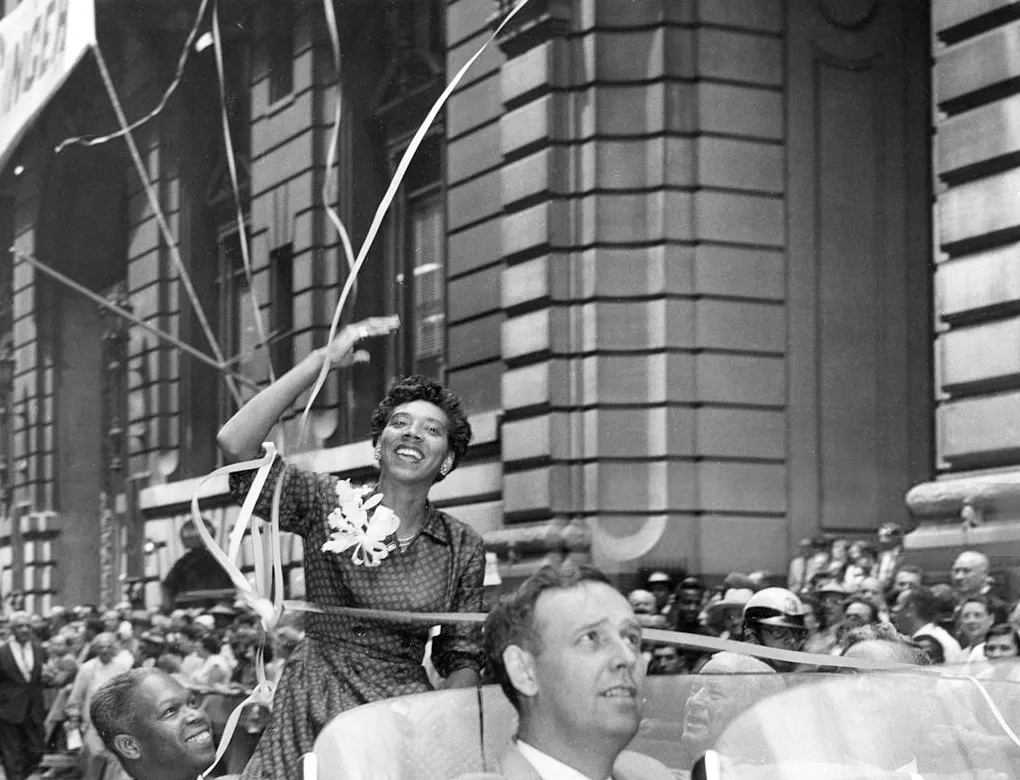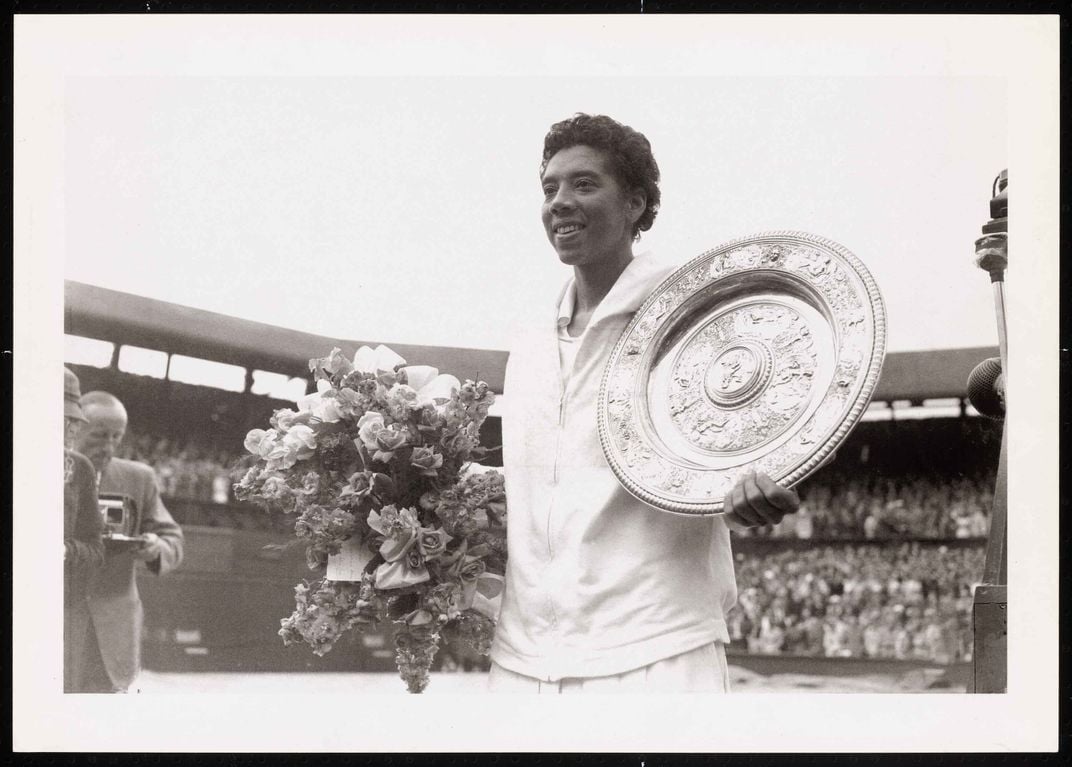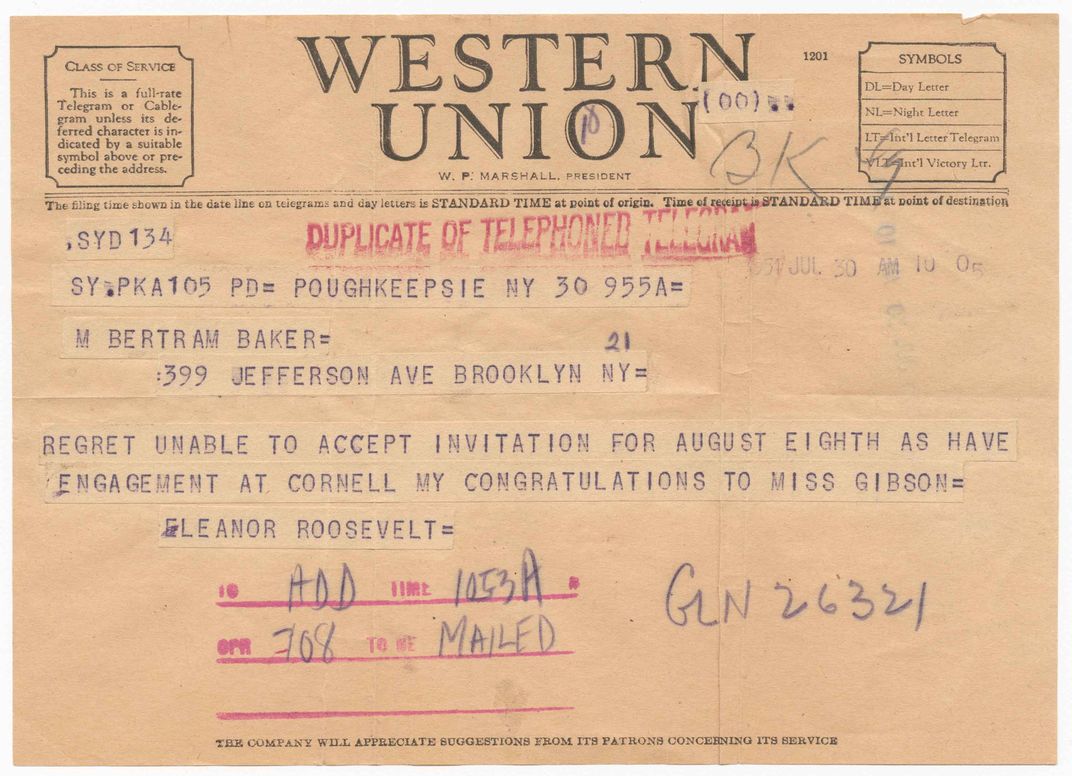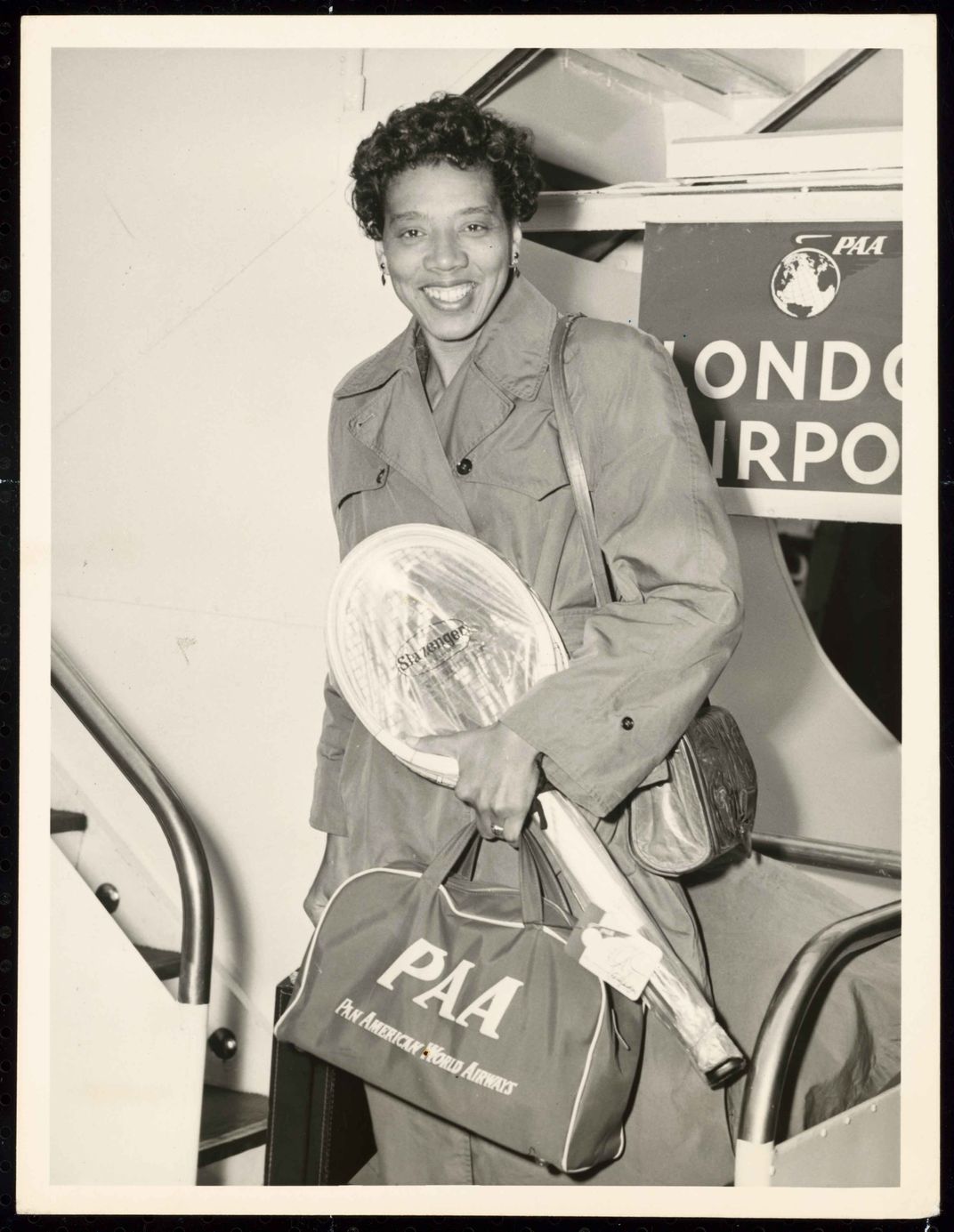The French Open Grand Slam tennis tournament is roiling as Naomi Osaka, one of the sport’s stars and a woman of color, has withdrawn in the face of threatened sanctions after she decided not to participate in post-match press briefings. Osaka took a stand to protect herself, but her move was in defiance of longstanding rules and traditions. Her action echoes the groundbreaking achievement by Althea Gibson at the same tournament 65 years ago, when Gibson became the first Black woman to win a major national tennis championship.
It wasn’t the first time Gibson had broken the color line in a sport traditionally associated with white elites. In 1950, Gibson, at age 23, was the first African American man or woman to compete at the U.S. National Championships, today known as the U.S. Open.
But it was the French title—in which she beat Angela Mortimer 6-0, 12-10—that won Gibson international recognition and launched her to even greater success. In the two years following, Gibson appeared in 19 major finals, winning 11 titles, including two singles titles at the All-England Tennis Club in Wimbledon (where she was congratulated by Queen Elizabeth II) and two singles titles at the U.S. National Championships. She also won five Grand Slam doubles titles.

It was a long time coming for Gibson, who started playing tennis as a teen in New York City’s Harlem neighborhood, and had won multiple national amateur tournaments—mostly sponsored by the American Tennis Association (ATA), the African American answer to the whites-only U.S. Lawn Tennis Association (precursor to today’s U.S. Tennis Association (USTA). Despite decades demonstrating her on-court prowess, until that French Open, she was never considered a top player, largely because of her race.
“American sports were still deeply segregated,” says Ashley Brown, a University of Wisconsin historian who is writing a biography of Gibson. The New Yorker could not have progressed without the support of a number of Black sponsors who nurtured her career. But Gibson also credited Jackie Robinson—who integrated Major League Baseball in 1947—in part for her ability to play in the U.S. National Championship in Forest Hills, New York, three years later.
Gibson’s entry to Forest Hills was all but guaranteed when Alice Marble, a revered American Grand Slam champion took to the pages of American Lawn Tennis in July 1950, calling out the sport’s bigotry. “If [Gibson] is refused a chance to succeed or to fail, then there is an uneradicable [sic] mark against a game to which I have devoted most of my life,” wrote Marble, according to an article by Brown in the Journal of Sport History. “To me, she is a fellow tennis player and, as such, deserving of the same chance I had to prove myself,” Marble wrote. Forest Hills was a dream come true, according to Brown. “One of these days, I’m going to be down there,” Gibson promised herself.
Gibson won her first match. The second—with the well-known Louise Brough—was interrupted by rain. When lightning shattered a stone eagle on top of the stadium, Gibson reportedly said, “It may have been an omen that times were changing,” according to a USTA article.
The integration of tennis is “different and distinct from the integration of baseball, basketball and football,” says Damion Thomas, a curator at the Smithsonian’s National Museum of African American History and Culture. “You’re talking about an elite, country-club sport, which has a very different meaning in society.”
Gibson donated many of her artifacts to the Smithsonian before she died in 2003, and is one of 75 black athletes featured in the museum’s sports galleries, in part because of the uniqueness of her story as a Black woman and an athlete, Thomas says.
She was celebrated by the Newport, Rhode Island-based International Tennis Hall of Fame in February in a virtual program led by Thomas and featuring Katrina Adams, the first Black woman to serve as president of the USTA. Gibson laid the groundwork for generations of Black men and women who yearned to prove themselves as worthy of being on court with white opponents—including Adams, who played on the pro tour from 1988 to 1999, and Venus and Serena Williams, among others.

Prize money and lucrative sponsorships were never in the offing for Gibson, as she played as an amateur. Tennis became a professional sport in 1968. And she did not play to win “acceptance” by the white audience. “She was a deeply competitive person,” says Brown. “She wanted to win and she wanted to challenge herself,” Brown says.
“It is not as if the goal was to get to the country club—the goal was to have as many opportunities that were available to you to compete at the highest levels, and to challenge notions of race,” says Thomas, about Gibson and other athletes at that time.
Gibson was not outspoken on race. According to the New York Times, she told a reporter in 1957, “I don’t consider myself to be a representative of my people. I’m thinking of me and nobody else.” She had been raised to believe that excelling individually could lead to better opportunities and access for all African Americans, Thomas says.
Her mentors—Hubert Eaton, an African American physician in Wilmington, North Carolina, and Robert Walter Johnson, a Black doctor in Lynchburg, Virginia—taught her how to “fit in” in the country club world, to rein in her emotions, and to comport herself in the “ladylike” manner expected of female tennis players. Gibson preferred shorts and pants, and keeping her hair cropped short. She sometimes clashed with the Black media, and tennis fans, who foisted heteronormative expectations on her, Brown says. Gibson “wasn’t necessarily interested in living up to these constructed ideas about how the game should be played,” Brown writes in an article in the Journal of African American History. She was often criticized as “mannish” for her 5-foot-11 height and power game. Gibson was feisty, sometimes, even described as mean—perhaps a result of her father’s boxing lessons and his history of abusing her.
The emotional control she learned—crucial for playing an individual sport like tennis—also served her well when she experienced subtle or not-so-subtle racism, says Thomas. Even as she rose to prominence, Gibson, like most African Americans, was not welcome at “whites-only” hotels or clubs when she traveled to tournaments. She stayed instead with friends or friends of friends, or in Black-owned hotels, says Brown.
Eaton and Johnson told her to play any ball that was within two inches of a line—essentially to be generous with calling a ball in or out—with an eye towards steering clear of any negative interaction with a white opponent, says Thomas.

Born in 1927 in South Carolina, Gibson was a daughter of sharecroppers who moved to New York in search of a better life, settling on 143rd Street in Harlem in 1930. The athletic girl took up paddleball on her street, which was regularly shut down for play by the Police Athletic League, and became a champion at age 12. A neighbor, sax player Buddy Walker, spotted her talent and, despite having little money himself, bought her used tennis racquets and started working with her on strokes.
Gibson came to the attention of Fred Johnson, the teaching pro at the all-Black Cosmopolitan Tennis Club, in Harlem, and one of the 150 such clubs in the 1940s and 1950s. Club members paid for her membership and began sponsoring her for ATA-sponsored tournaments. Beginning in 1947, Gibson won the ATA national title for 10 straight years. In 1949, she earned a tennis scholarship to Florida A&M, a historically Black university in Tallahassee.
While a college student, she not only played at Forest Hills, but also competed at Wimbledon for the first time, in 1951. Gibson was still not getting the same recognition as contemporary white women players—such as Louise Brough, Maureen Connolly or Doris Hart.
But then, in 1955, her life changed. The U.S. State Department asked Gibson to go on an international goodwill tour with three other tennis players, all white. Brown says Gibson was selected in part because of another momentous event in 1955—the lynching of Emmett Till. The State Department saw Gibson as the perfect foil to counteract the Soviet Union’s campaign to portray America as a racist nation, says Thomas.
Gibson and her fellow players toured southeast Asia for six months, playing exhibition matches, meeting dignitaries and locals, and giving lessons to children. “She credits this tour with giving her the opportunity to focus on tennis,” says Thomas. When the tour ended, Gibson stayed overseas for another six months, which led to her biggest breakthroughs in tennis. In 1957, she returned home to win at Forest Hills, after which she was then given a ticker-tape parade down Broadway—becoming only the second African American, after Jesse Owens, to receive that honor. That year, Gibson made the cover of both Sports Illustrated and Time.
“Who would have thought that she would have ended up here, being celebrated by the Queen and presidents and all of America,” says Thomas.

Soon after, though, Gibson retired as an amateur and attempted to become a pro tennis player, but there wasn’t much money in the sport, especially for women. Her retirement was not a surprise, says Brown, noting that Gibson had started playing tennis at 13, and that by age 31, she had endured enough physically. She was also looking for a change, and more importantly, financial stability, Brown says.
Gibson played exhibition matches on a tour with the Harlem Globetrotters and returned to an early love of singing, recording an album. It did not sell well. Then she pivoted back to sports, becoming the first Black woman to join the Ladies Professional Golf Association (LPGA) tour in 1964, when she was 37. The tournaments did pay, but Gibson never won an LPGA title. “Some might say I’m being generous to say she had middling success in golf,” says Brown.
After that disappointment, Gibson tried her hand at various occupations, including a failed bid for the New Jersey state Senate in 1977. She was an athletic director for Essex County, New Jersey, a recreation director for the city of East Orange, and also returned to tennis by running clinics and education programs for under-served urban areas. Eventually, she had two short-term coaching gigs, mentoring Leslie Allen and Zina Garrison, both Black women who made it on the pro tour.
But unlike many professional tennis players of the modern era—and even some amateur players from earlier years—Gibson was never given the opportunity to parlay her on-court success into a teaching job at a resort or club, or a long-term coaching or broadcasting career.“Most tennis stars of her caliber were able to continue making a living in tennis,” says Thomas. Not Gibson.
She speculated that her race and sex were primary reasons why she was never offered a teaching position, says Brown. “To hail my talents in public doesn’t cost anything, but to hire a Negro—and a Negro woman at that—to teach White club members called for a bigger expenditure of courage than most club owners were willing to make,” Gibson said, according to Brown, writing in the Journal of Sport History.

Gibson had also once said that she wasn’t especially interested in coaching. But, says Brown, “we can’t help but think she’d accept something if it came along,” given her desire for financial stability.
She was inducted into the International Tennis Hall of Fame in 1971, but was not formally recognized by the USTA until 2019, when the Althea Gibson Sculpture Garden was unveiled at the U.S. Open campus, now in Flushing Meadows, New York.
It was a bittersweet coda from the USTA. In the 1980s, when Gibson had several strokes and was on the verge of bankruptcy, no tennis organization responded to her pleas for help. And yet, Gibson donated many of her most valuable items to the Smithsonian, “at a time when it might have been helpful and beneficial to her to have those items to sell,” says Thomas.
Two of Gibson’s close friends—her former doubles partner, Angela Buxton, an Australian, and Frances Clayton Gray, of East Orange—spread the word that Gibson needed help and brought in donations to help her survive.
Gibson died in 2003 at age 76.
Her story is not just one of an individual succeeding despite coming from modest means, and in the face of racism and sexism. It should also “invite us to think about what happens to all athletes when they retire and move on,” says Brown. “It becomes easy for people to move on and forget about the forebears,” she says.
Explore Althea Gibson’s career highlights across a range of artifacts held in Smithsonian’s multiple museum collections.
/https://tf-cmsv2-smithsonianmag-media.s3.amazonaws.com/filer/6a/3b/6a3be317-73f3-4cac-8409-256fe4b00457/longform_mobile.jpg)
:focal(811x200:812x201)/https://tf-cmsv2-smithsonianmag-media.s3.amazonaws.com/filer/70/20/7020b698-77d0-43da-a4aa-5bd1113f9fad/althea_social.jpg)
/https://tf-cmsv2-smithsonianmag-media.s3.amazonaws.com/accounts/headshot/AliciaAult_1.png)
/https://tf-cmsv2-smithsonianmag-media.s3.amazonaws.com/accounts/headshot/AliciaAult_1.png)